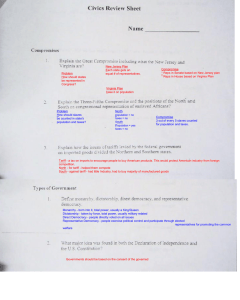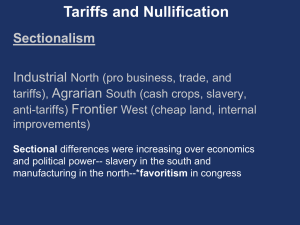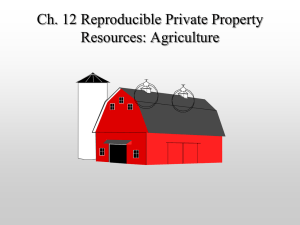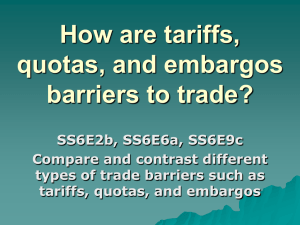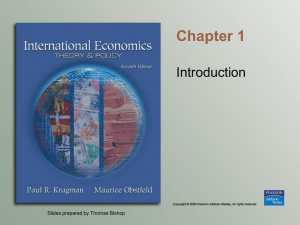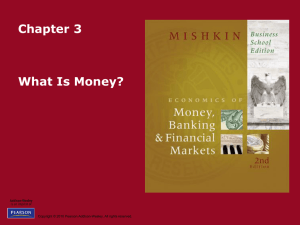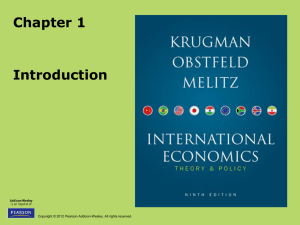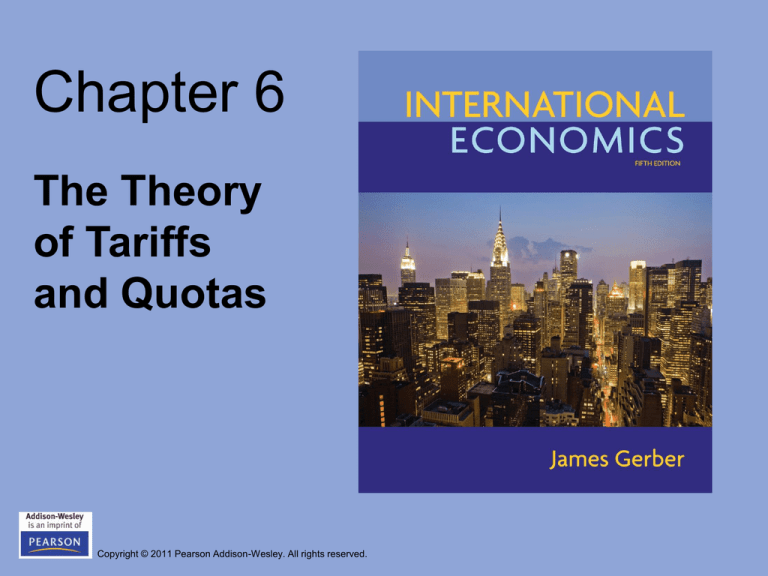
Chapter 6
The Theory
of Tariffs
and Quotas
Copyright © 2011 Pearson Addison-Wesley. All rights reserved.
Guidelines to study
• Follow the book, ch. 6
• Paragraphs excluded: ‘effective vs. nominal
rate of protection’
Copyright © 2011 Pearson Addison-Wesley. All rights reserved.
6-2
Chapter Objectives
• Introduce the theory of tariffs
• Discuss the welfare and efficiency effects of
tariffs
• Analyze the distinction between tariffs and
quotas
Copyright © 2011 Pearson Addison-Wesley. All rights reserved.
6-3
Analysis of a Tariff
• There are numerous barriers to trade, some
are obvious (transparent), others are not
(non-transparent)
– Quotas: direct limit on imports: regulate the
quantity of imports
– Tariffs: indirect limit on imports: impose a tax
on imports
– The so-called ‘Non-tariff barriers’ such as health
and environmental regulations
Copyright © 2011 Pearson Addison-Wesley. All rights reserved.
6-4
Analysis of a Tariff (cont.)
• Tariffs and quotas encourage
– Consumers to switch to relatively cheaper domestic
goods (without tariffs more expensive) or to drop out of
the market
– Producers to increase their output as demand switches
from foreign to domestic goods
• This chapter is a partial equilibrium analysis of the
effects of tariffs and quotas: considers only their
impact on the industry on which they are imposed,
rather than their economy-wide effects
Copyright © 2011 Pearson Addison-Wesley. All rights reserved.
6-5
Prices, Output, and Consumption
• Assume a super-simplified setting to understand the main
effect (the results hold also in more general models):
1. There is only one price for a good (world price Pw)
2. Foreign producers are willing to supply us with all of
the units of the good we want at that price
Implicitly, this means that the home country
demand for the good is relatively small and does
not affect the price (VERY IMPORTANT POINT )
Copyright © 2011 Pearson Addison-Wesley. All rights reserved.
6-6
FIGURE 6.2 Domestic Supply and Demand
for an Imported Good
Domestic
production
Copyright © 2011 Pearson Addison-Wesley. All rights reserved.
Q2-Q1=imports
Domestic
demand
6-7
Prices, Output, and Consumption
(cont.)
• Now assume: Government imposes a tariff of
amount “t.” Importers will still be able to buy the
good from foreign producers for Pw, but they
will have to pay the import tax of “t.”
– The tax is subsequently tacked onto the price to
domestic consumers: price to them is Pw + t=Pt
– The consumption of the imported good
subsequently decreases
Copyright © 2011 Pearson Addison-Wesley. All rights reserved.
6-8
FIGURE 6.2 Domestic Supply and Demand
for an Imported Good
P’w=t+Pw
Copyright © 2011 Pearson Addison-Wesley. All rights reserved.
At the new price,
imports decline
and domestic
production
increases
6-9
Prices, Output, and Consumption
(cont.)
• Furthermore,
– The domestic production of the good increases
as domestic firms are able to charge a higher
price while remaining competitive vis-à-vis
foreign firms.
– Finally, imports of the good decrease
Copyright © 2011 Pearson Addison-Wesley. All rights reserved.
6-10
Resource Allocation and Income
Distribution
• Besides the rise in prices and fall in imports,
tariffs influence
– inputs in domestic production: the increase in domestic
production requires additional resources of land, labor,
and capital to be reallocated from their prior uses. This
can be costly, especially because less resources will be
available in other (more productive) sectors. (this is a
general eq. effect that cannot be seen in a 1-sector
analysis)
– Overall welfare effect and the income distribution
between producers and consumers.
Copyright © 2011 Pearson Addison-Wesley. All rights reserved.
6-11
Tariff and Income Distribution
The main distributive effect of a tariff is to transfer resources
from consumers to producers. To see this let me introduce two
concepts:
–Consumer surplus: value received by consumers in excess
of the price they pay, i.e. difference between the willingness to
pay for the good (that depends on income, preferences,
physical conditions, etc.) and the price
–Producer surplus: value received by producers in excess of
the minimum price at which they are willing to produce.
–Consumer and producer surpluses can be measured only if
the demand and, respectively, the supply curve are known.
Copyright © 2011 Pearson Addison-Wesley. All rights reserved.
6-12
FIGURE 6.1 Consumer and Producer Surplus
Question: what
happens to the
producer and
consumer
surplus if the
price increases?
Consumer
surplus
Producer
surplus
Copyright © 2011 Pearson Addison-Wesley. All rights reserved.
6-13
FIGURE 6.3 The Effects of a Tariff
The area c
measures the
tax collected
with the tariff
Pretariff
price
Copyright © 2011 Pearson Addison-Wesley. All rights reserved.
6-14
TABLE 6.1
Economic Effects of the Tariff
in Figure 6.3
•
tariff raises the price in the importing country:
– consumer surplus decreases (consumers worse off)
– producer surplus increases (producers better off).
– the government collects tariff revenue equal to the tariff rate times
the quantity of imports with the tariff.
•
The net effect of the tariff on national welfare = gains to producers (a) +
gains to government (c) - losses to consumers (a+b+c+d)= (a + b + c +
d - a - c) =
-(b + d)
• The tariff brings about a decline in the national welfare: The tariff
distorts production and consumption decisions so that producers
produce too much and consumers consume too little.
Copyright © 2011 Pearson Addison-Wesley. All rights reserved.
6-15
TABLE 6.1
Economic Effects of the Tariff
in Figure 6.3
Copyright © 2011 Pearson Addison-Wesley. All rights reserved.
6-16
The Large Country Case
• Economists distinguish between small and large
countries in analyzing the effect of a tariff
-Large country: one that imports enough of a particular
product so that if it imposes a tariff, the exporting
country will reduce its price of the good in order to keep
its share of the large country's market
• In theory, large countries can improve their
national welfare by imposing a tariff (as long as
their trading partners do not retaliate, I will clarify
this point in policy lecture)
Copyright © 2011 Pearson Addison-Wesley. All rights reserved.
6-17
Analysis of Quotas
• Quota: A quantitative restriction that specifies a
limit on the quantity of imports
• Differences between quotas and tariffs
– Tariff limits imports by imposing a tax on them
– Unlike tariffs, quotas do not generate tariff revenue for
the government (but extra profits for foreign producers)
• Similarities between quotas and tariffs
– Both lead to a reduction in imports, a fall in total
domestic consumption, and an increase in domestic
production
Copyright © 2011 Pearson Addison-Wesley. All rights reserved.
6-18
FIGURE 6.7 Analysis of a Quota: 2
• In the case of a tariff, the government earned revenue from
imports; in the case of a quota, foreign producers receive
extra profits (c)
Copyright © 2011 Pearson Addison-Wesley. All rights reserved.
6-19
FIGURE 6.6 Analysis of a Quota: 1
• Quota rents: Increased profits accruing to foreign
producers from the use of quotas; take the place of
tariff revenue
Copyright © 2011 Pearson Addison-Wesley. All rights reserved.
6-20
The Effect of quota and tariffs on
profits
• Foreign producers prefer quota over tariffs
as they can obtain quota rents.
– Remember that: unlike tariffs, quotas do not generate
tariff revenue for the government (but extra profits for
foreign producers).
– Put it differently, the advantages of protection go to the
foreign producers that are selected to export and that
can charge higher prices.
Copyright © 2011 Pearson Addison-Wesley. All rights reserved.
6-21
The Effect of quota and tariffs on
the profits
• Two circumstances that can limit quota rents
(i.e. rents for foreign producers)
– If there is a large number of foreign producers,
competition may limit their ability to increase
prices
– The government can extract the extra profits from
foreign producers through an auction for import
licences
Copyright © 2011 Pearson Addison-Wesley. All rights reserved.
6-22
Types of Quotas
1) Limitation on the quantity of imports: e.g., a limit on
the quantity of imports from country x, or a limit on
the quantity of imports from the rest of the world as a
whole
2) Import licensing requirement: forcing importers to
obtain government licences for their imports;
government regulates the number of licences
available
3) Voluntary export restraint (VER) (or voluntary
restraint agreement, VRA): the exporting country
“voluntarily” agrees to limit its exports for a period
Copyright © 2011 Pearson Addison-Wesley. All rights reserved.
6-23
Types of Quotas: VERs
• VERs have similar effects as quotas
– However, VERs are more popular, as they (1) do not
require domestic legislative action; and (2) allow
politicians to provide protection for domestic industry
and to appear as proponents of free trade
• The use of VERs increased with the decline in
tariffs that results from the global trade rounds;
however, recent international negotiations have
restricted the use of VERs (cars’ imports from
Japan to the US in the 80s)
Copyright © 2011 Pearson Addison-Wesley. All rights reserved.
6-24
Open issues on protectionisms
and free trade
1. Generally, tariff rates in developing nations are higher than developed
nations. Why?
Copyright © 2011 Pearson Addison-Wesley. All rights reserved.
6-25
– For developing countries, tariffs are one of the few sources of government revenues
needed to invest in infrastructures, health and public education.
– Moreover, in developing countries, tariffs allow to protect the infant industry in
presence of economies of scale. Germany and the US used extensively tariffs in the
nineteen century to catch-up with the UK (see lecture on developing countries).
Copyright © 2011 Pearson Addison-Wesley. All rights reserved.
6-26
FIGURE 6.4
Average Tariff Rates, 1986-2007
Copyright © 2011 Pearson Addison-Wesley. All rights reserved.
6-27



